Alan Cathcart | July 26, 2018
Midsize Maestro?
We test BMW’s latest entry into the world of urban mobility
It’s been exactly seven years since BMW Motorrad re-entered the personal-transportation sector, after coming to the party a bit too early back in 2000 with the, er… idiosyncratic C1; the prices for which have since gone through the roof—very aptly, since, of course, it had one.
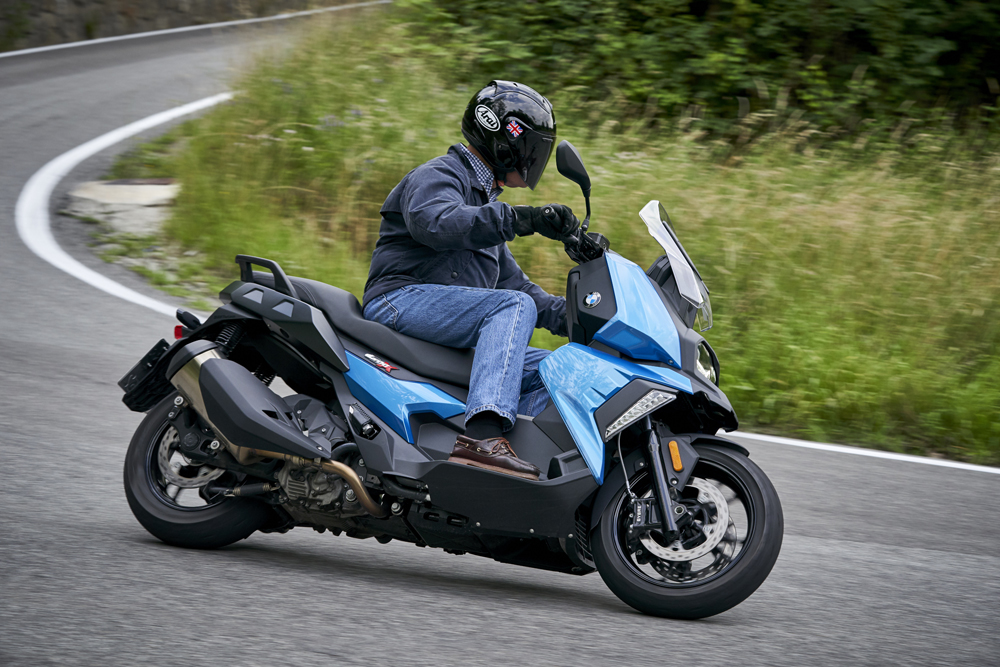 Light weight and compact, the C400X features agile handling and easy riding.
Light weight and compact, the C400X features agile handling and easy riding.
BeeEm’s comeback to the two-wheeled world of urban mobility came in July 2012, with the advent of its maxi-scooter duo, the C650GT and C600 (since uprated to C650 Sport). Their parallel-twin engines were and still are made in China by Loncin—BMW’s established Asian partner, which had from 2009 onwards also produced the G650GS single-cylinder motorcycle’s 652cc engine. The German manufacturer’s steep pricing for its twist-n-go twins hasn’t deterred 70,000 examples of them from finding customers since then, alongside around 1200 versions each year of the even costlier full-electric C evolution E-scooter, which appeared two years later, in 2014.
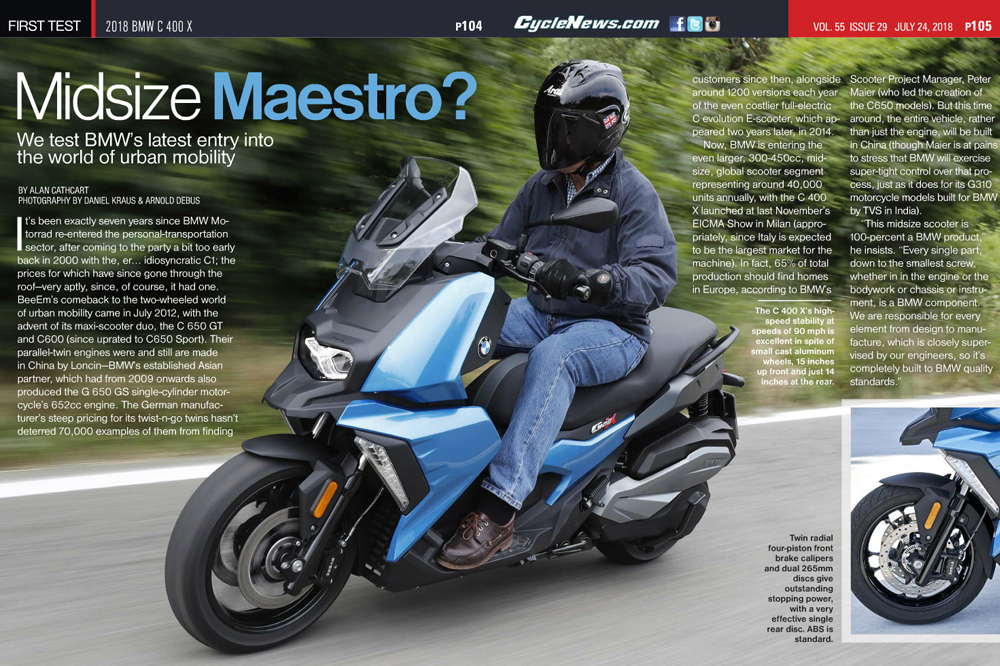
PHOTOGRAPHY BY DANIEL KRAUS & ARNOLD DEBUS
Click here to read this in the Cycle News Digital Edition Magazine.
Now, BMW is entering the even larger, 300-450cc, midsize, global scooter segment representing around 40,000 units annually, with the C400X launched at last November’s EICMA Show in Milan (appropriately, since Italy is expected to be the largest market for the machine). In fact, 65% of total production should find homes in Europe, according to BMW’s Scooter Project Manager, Peter Maier (who led the creation of the C650 models). But this time around, the entire vehicle, rather than just the engine, will be built in China (though Maier is at pains to stress that BMW will exercise super-tight control over that process, just as it does for its G310 motorcycle models built for BMW by TVS in India).
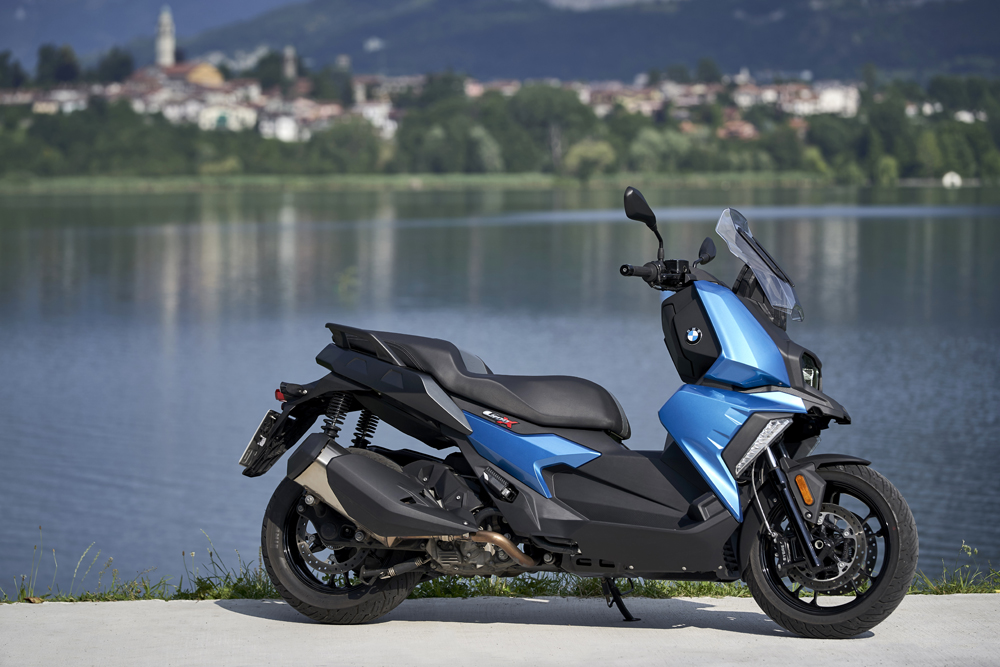 The C400X is the first midsize scooter developed in Germany, but to be wholly manufactured in China by Loncin.
The C400X is the first midsize scooter developed in Germany, but to be wholly manufactured in China by Loncin.
“This midsize scooter is 100-percent a BMW product,” he insists. “Every single part, down to the smallest screw, whether in in the engine or the bodywork or chassis or instrument, is a BMW component. We are responsible for every element from design to manufacture, which is closely supervised by our engineers, so it’s completely built to BMW quality standards.”
This is doubtless aimed at allaying any concerns for customers with long memories. After BMW switched production of its complete G650GS motorcycle to the Loncin factory in 2009, it soon became aware of various quality problems associated with outsourcing it to China, and repatriated manufacture to its Spandau factory in Berlin in 2011, leaving Loncin to manufacture only the engines. However, judging by the good build quality of the array of C400X scooters fresh out of China, which awaited us for the June press launch just north of Milan, such issues have been successfully addressed this time around. Indeed, the perceived quality of the switchgear, or of the plastics of, say, the pair of lockable storage bins in front of your knees (with a 12V socket in the right one, which has room to charge a large smartphone), is fully in-line with competitors’ products, and arguably of better quality than on BMW’s own larger C650 models.
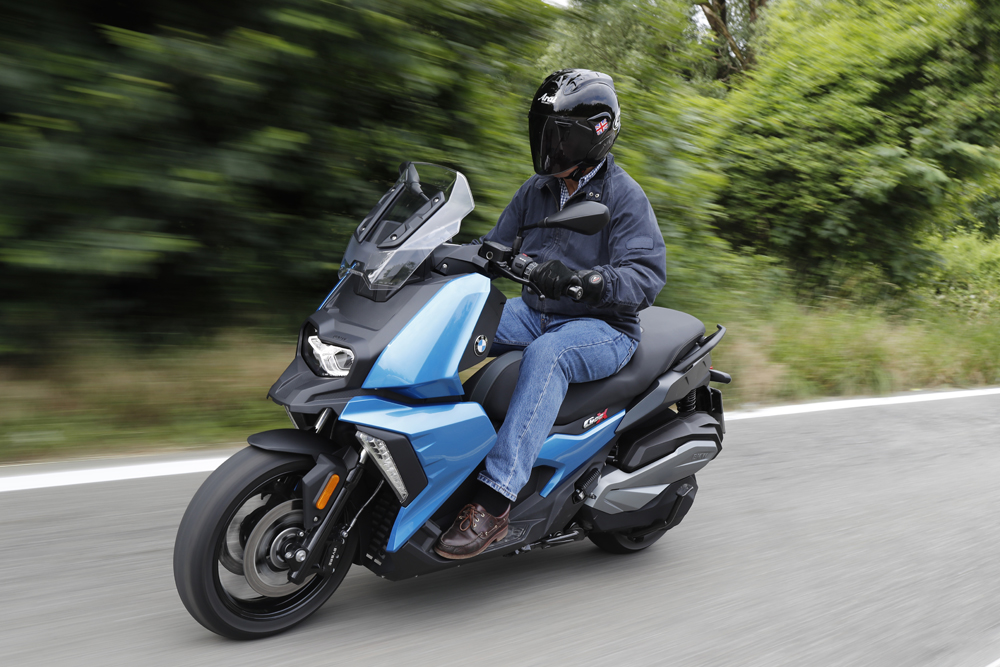 The C400X’s high-speed stability at speeds of 90 mph is excellent in spite of small cast-aluminum wheels, 15 inches up front and just 14 inches at the rear.
The C400X’s high-speed stability at speeds of 90 mph is excellent in spite of small cast-aluminum wheels, 15 inches up front and just 14 inches at the rear.
Having begun clean-sheet development of the C400X four years ago, in 2014, production of this 2019-model scooter began in China on July 1, according to Maier, with deliveries to European dealers commencing in early October, followed by the USA and Australia before year’s end. This is indeed a world model, though it’s expected that Italy, France, Germany and Spain will inevitably be the leading markets for it, followed by the USA, says Meier. As such, it’s more competitively priced than the C650. In some ways, the BMW offers a step up with its level of equipment, such as the optional 6.5-inch, full-color TFT screen; the first on this type of scooter. The two big BMW roundels on either side of the C400X obviously count for something, as does the very Bavarian shade of Zenith Blue it’s available in, alongside Arctic White with a broad, red seat stripe (and later on, says Maier, all-black). The C400X’s sporty styling is certainly distinctive, and clearly denotes its brand heritage, with a vestigial beak hinting at its GS relatives, and BMW’s trademark asymmetric styling for the LED headlight (with fiber-optic DRLs as an extra).
Despite the C400X label, BMW’s new midsize scoot is actually a 350cc model, powered by a liquid-cooled, fuel-injected, chain-driven, SOHC, four-valve engine, measuring 80 x 69.6mm, which makes a respectable 34bhp/25kW at 7500 rpm, and peak torque of 35Nm/25.8 ft-lb at 6000 revs. By way of comparison, Yamaha’s 395cc XMAX400 gives 32.6 bhp/24.5kW at 7000 rpm and 36Nm/26.6 lb-ft also at 6000 rpm. The BMW’s wet-sump engine is attached to a CVT transmission, and following traditional scooter practice, the entire powerplant comprises part of the cast-aluminum, double-sided swingarm.
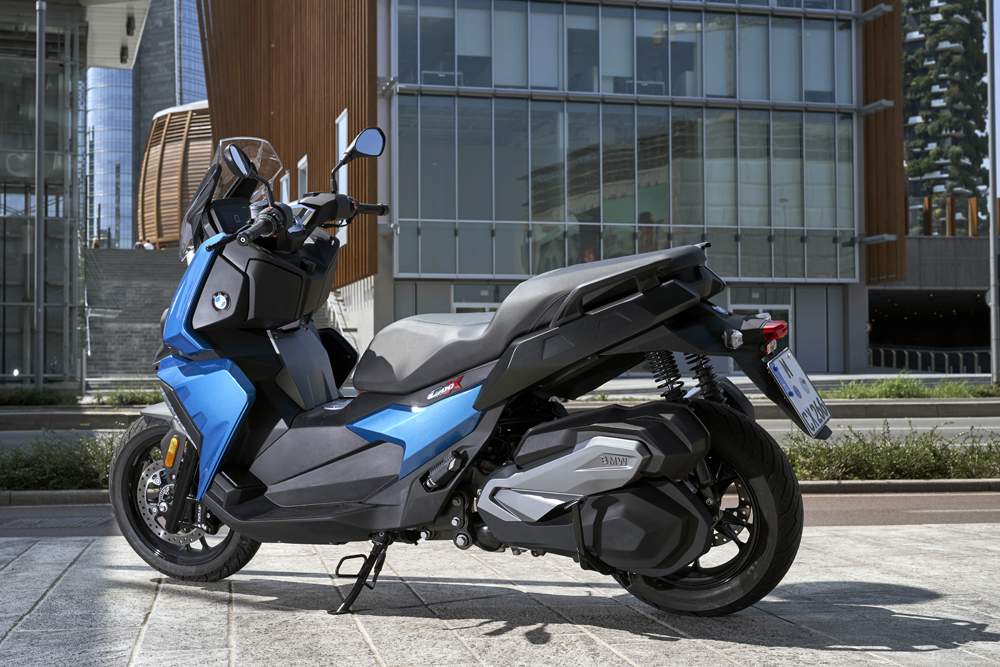 The C400X is powered by a liquid-cooled 350cc fuel-injected SOHC four-valve engine, making 34 bhp/25kW at 7500rpm; peak torque is 35Nm/25.8ft-lb at 6000 rpm.
The C400X is powered by a liquid-cooled 350cc fuel-injected SOHC four-valve engine, making 34 bhp/25kW at 7500rpm; peak torque is 35Nm/25.8ft-lb at 6000 rpm.
BMW has tried to ensure the C400X lives up to its established standards in terms of refinement, employing a gear-driven counterbalancer inside the engine, as well as a unique rubber mounting system for the swingarm/engine unit that the firm claims eliminates vibrations without sacrificing chassis rigidity. There is indeed hardly any vibration, and the mirrors stay still at all speeds up to the 86 mph claimed maximum (though I saw an indicated 89 mph on an autostrada). The BMW was completely stable at any speed, and what despite appearances is a non-adjustable screen (shame!) actually gave a surprising amount of protection to a 5-foot 10-inch rider. There’s an optional taller screen (and lower 30-inch seat, as opposed to the 30.5-inch stock one) for those who wish.
It’s a pretty satisfying mileater despite the engine’s smaller capacity, though its biggest attribute is its torquey response from low speeds—BMW has obviously focused on delivering zestful acceleration as a prime part of the package.
Chassis-wise on the C400X, there’s a pretty meaty tubular steel frame which carries a conventional, non-adjustable, 35mm telescopic fork up front, matched to twin shocks adjustable for spring preload at the rear.
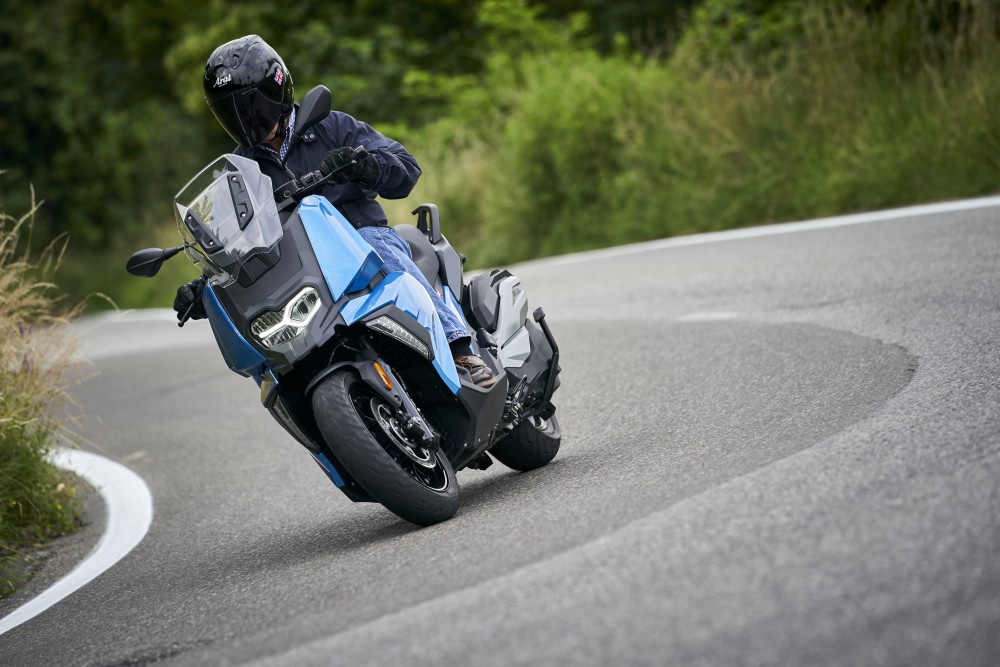 The BMW C400X is scheduled to start arriving in the U.S. in December.
The BMW C400X is scheduled to start arriving in the U.S. in December.
The wheelbase is a lengthy 61.6 inches, but the small, cast-aluminum wheels (15 inches up front and just 14 inches at the rear) make it look even longer. However, steering geometry is similar to a motorcycle’s, with a 26.4-degree fork rake and 3.2 inches of trail, and 4.3/4.4 inches of wheel travel front and rear, respectively.
So too is the ByBre (Brembo’s Asian/Indian-markets offshoot) brake package, with the meaty-looking twin, rigidly mounted, 10.4-inch discs gripped up front by a pair of four-piston floating radial calipers, and a single-pot rear squeezing the same-size disc that’s effective enough to use on its own in town.
Curb weight with the 3.4 gallon fuel tank between your feet (which provides a convenient place for stacking shopping and suchlike in best Latin scooterista mode!) fully topped up, the C400X scales 450 pounds (13.2 pounds less than the XMAX 400), with a balanced 50/50 split front-to-rear.
Two-channel ABS is of course standard, but this time by Continental rather than Bosch, and they’re also responsible for the traction-control, aka “ASC/Automatic Stability Control”, included as stock. The Pirelli Angel Scooter tires, which Maier says were developed by the Italian company specifically for the C400X, show that this is not a cut-price scooter, and they give good grip as well as heaps of confidence from the front end when keeping up speed while rolling from side to side in hilly terrain.
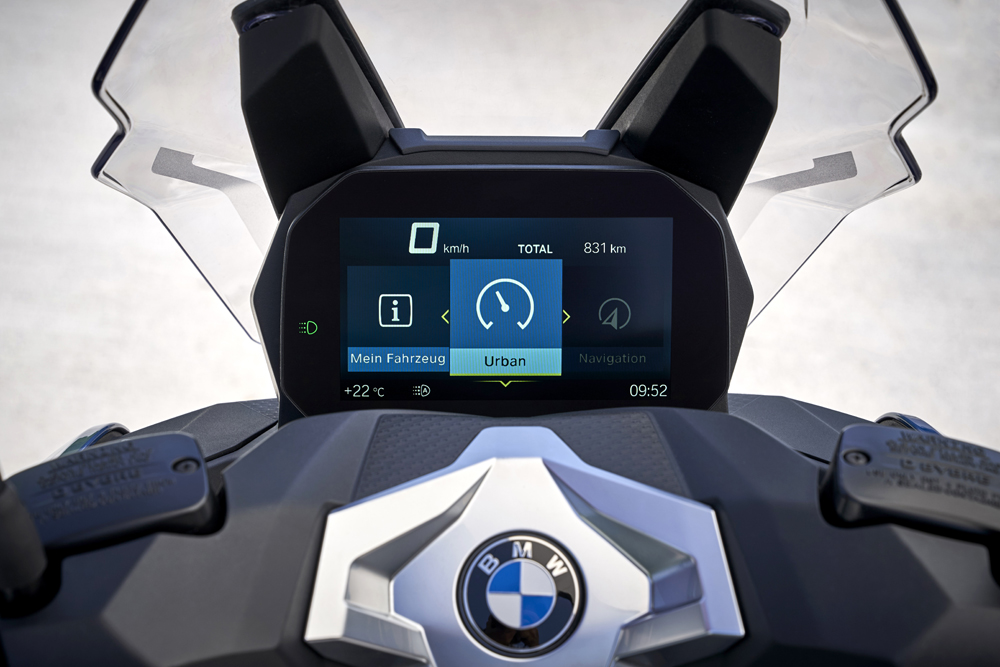 Sophisticated optional TFT dash offers complete connectivity via Bluetooth and wide range of digital aids.
Sophisticated optional TFT dash offers complete connectivity via Bluetooth and wide range of digital aids.
BMW evidently intended to deliver a sporting feel to the C400X, hence the lack of a traditional feet-forward riding position (a necessary compromise to keep the scooter as a whole short and agile). The seat’s quite wide and relatively plush for both rider and passenger, the latter of whom benefits from two well-positioned handgrips. The riding position feels very natural as well as relaxing, with room to put your feet flat on the floorboard, or just a little forward if you don’t mind bending your ankles. That’s because wind-tunnel testing showed this stance protects your feet better in wet-weather riding. Even my mate Gerhard Lindner, who in spite of being 6’2” was Germany’s 600 Supersport Champion before going to work for BMW, could sit normally on the C400X without his knees touching the bodywork, so it’s well-thought-out for riders of all sizes.
Thumb the starter and the 350cc four-stroke engine’s deep-sounding stainless-steel exhaust has a pleasantly rorty sound without being over-loud. Setting off in the deep gravel in front of the hotel had the standard TC/ASC cutting in sharply, but not too easily, to give reassurance you must be prepared to receive! You can turn the system off from the settings menu, but it’ll reset the next time you stop the engine.
This BMW scooter is easy to ride at low speeds, with good throttle response that’s instantaneous, but not aggressive—the connection between twist-grip and rear wheel is more typical of a motorcycle than a scooter, as expressed audibly via the engine note. Pickup is immediate without being snappy, and that makes the new BMW a super traffic tool—it’s very easy to move up a line of cars and vans just by twisting your right wrist hard when you spot a gap, thanks to the torquey but willing engine that bats higher than its 350cc capacity would lead you to expect.
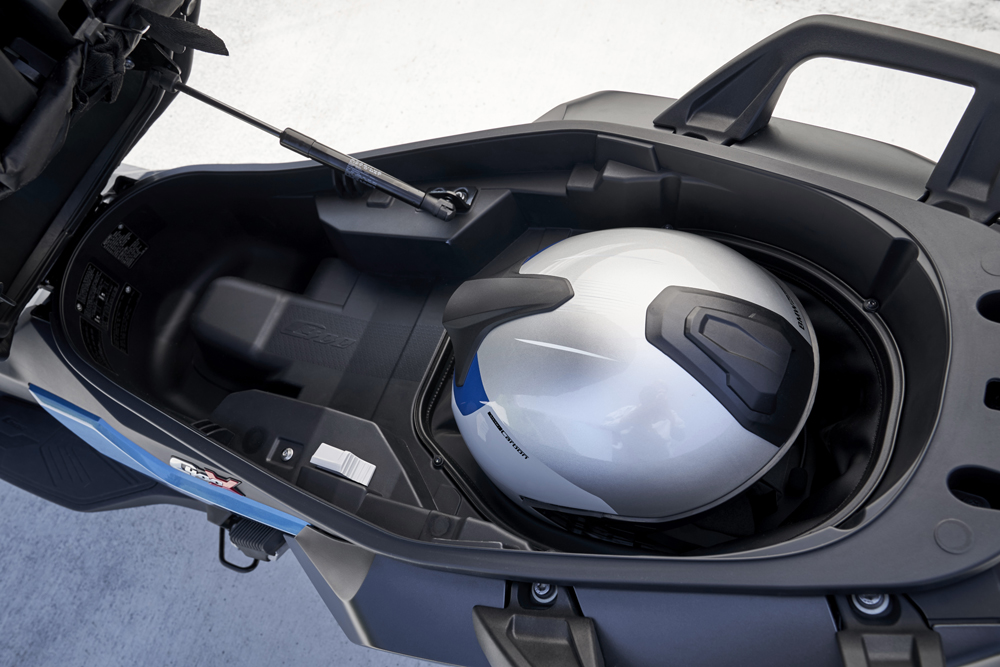 By typical scooter standards, storage might be considered a little lacking, but you can still squeeze in a full-face helmet.
By typical scooter standards, storage might be considered a little lacking, but you can still squeeze in a full-face helmet.
Feet-up U-turns are easy, and the capable, well-balanced feeling of the whole package makes it seem nimble and responsive without feeling nervous, as small-wheeled scooters can often appear. Plus, it’s much slimmer than any maxi-scooter and barely more imposing than a big 125, which makes splitting lanes something you’ll do with confidence when slicing through traffic.
But the suspension is a bit choppy, especially the twin-shock rear end which skips around a little over the kind of bumpy, ill-maintained roads that are sadly becoming ever more commonplace in cash-starved Italy. The radial front brakes work brilliantly well without being too aggressive in response, and the rear is equally immediate, without the ABS being too intrusive if you squeeze the left-hand lever too enthusiastically.
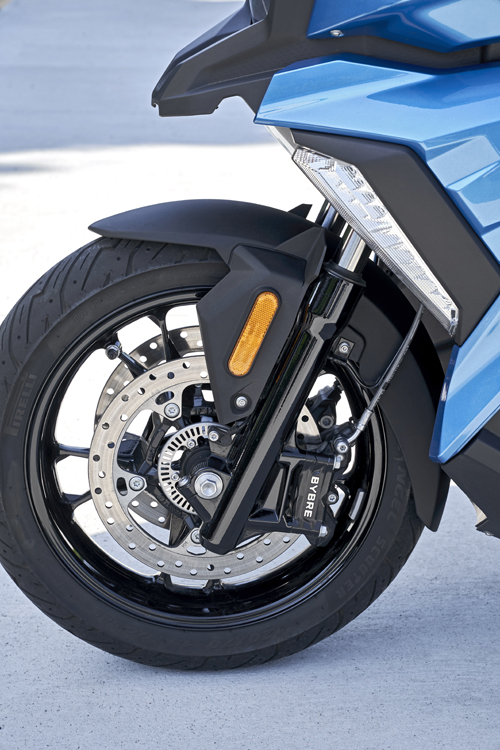 Twin radial four-piston front brake calipers and 265mm discs give outstanding stopping power, with a very effective single rear disc. ABS is standard.
Twin radial four-piston front brake calipers and 265mm discs give outstanding stopping power, with a very effective single rear disc. ABS is standard.
The keyless ignition (a $340 option) is a real plus, automatically locking the ignition, the seat and the two front pockets, while the $465 Comfort pack features heated grips and seat. But it’s that large TFT screen, which is completely legible in sunlight, that makes the BMW stand out, accessed via the easy-to-use multi-function controller on the left handlebar. It can be paired to a smartphone and BMW’s Motorrad Communication System via Bluetooth, giving access to media playback and telephone functions. It also displays arrow-based navigation via the BMW Motorrad Connected App on either Android or IOS. Connectivity is nothing new in the world of scooters, but the C400X’s optional package is closer to what you’d find on a K1600 than on other scooters. The only drawback is the navigation system is restricted to just A-to-B directions indicated by arrows, not a conventional GPS map, which BMW states is on the way (without giving a date when it’ll be available).
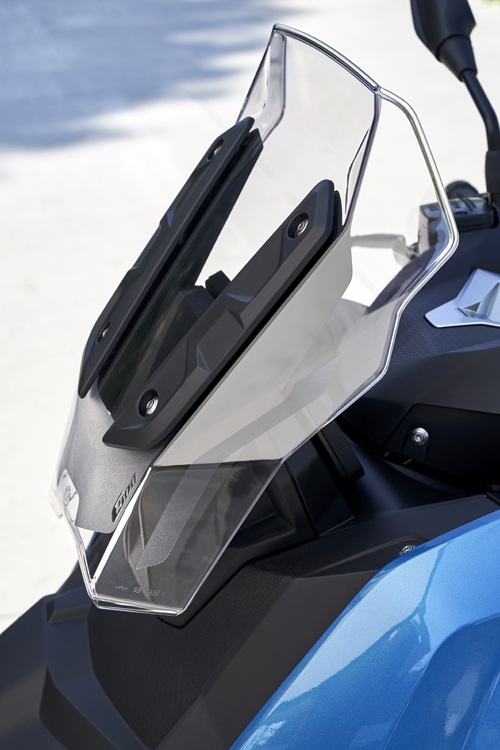 Overall wind and element protection is quite good.
Overall wind and element protection is quite good.
“Anyway,” says Peter Maier, “our feedback from scooter riders is that they ride their machine specifically to get from one place to another—reaching the destination is what interests them, not the journey.”
That app on your phone will also allow you to find where you last parked, check the weather, see where the nearest gas station is, and view various data from the scooter, including mileage, riding time and average speed. You have an option to automatically record your rides and view them later, and the app even lets you automatically embed any photos you take during the journey. Cleverly, a minimum distance can be set between one and 50 miles before recording starts (to avoid logging every ride to work), as well as a minimum duration between one and five hours, and a maximum break time of between five minutes and 24 hours.
Tightening up the architecture of the C400X in pursuit of better handling means that its under-seat storage is only big enough to house an open-face helmet and a few other loose items, although once stationary, the BMW Flexcase system included as standard expands sufficiently to allow space for a full-face helmet to be stored alongside a half-face one—though it must be removed (and presumably worn!) before riding away.
BMW claims a fuel consumption of 0.9 gallons per 62 miles, and even ridden quite hard, including at maximum speed on the autostrada, the average given by the on-board computer during my ride dropped only slightly—good enough for a range of just over 185 miles. That’s pretty practical, and I imagine many commuters will probably only be filling up once a week. As with other BMW models, service intervals are every 6000 miles, with a CVT-belt inspection at every second service. There’s a convenient side stand and an easy-on/easy-off center stand that’s very stable.
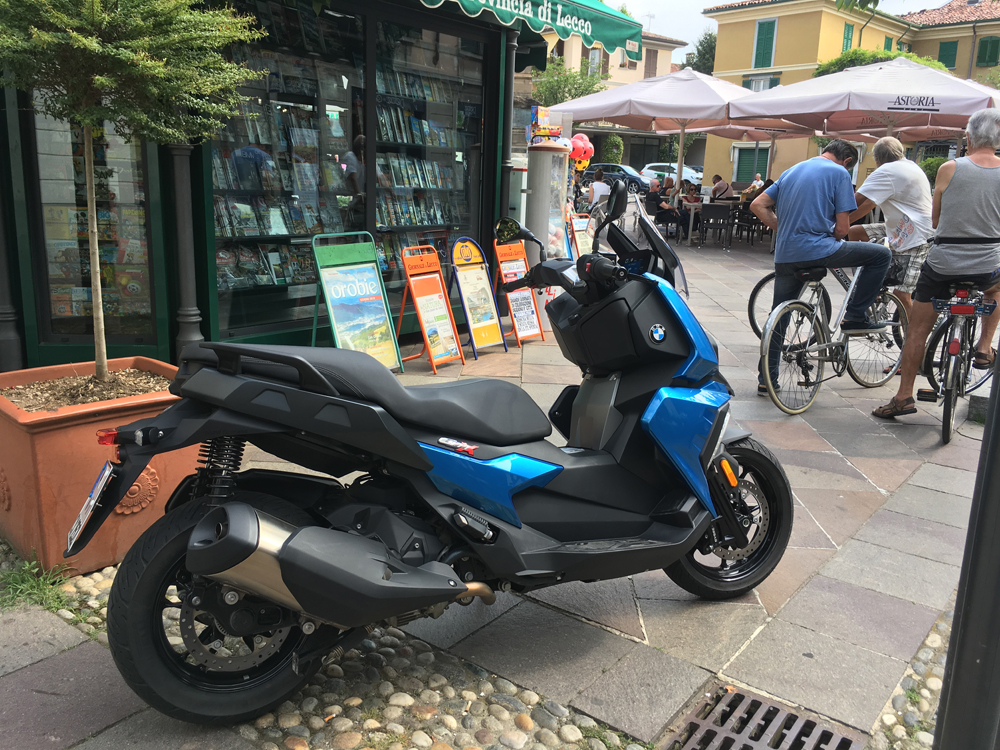
With the C400X, BMW has delivered a well-priced and especially well-spec’d product with, yes, good build quality, to an increasingly important section of the two-wheeled marketplace that’s consistently growing in numbers. More drivers abandon their urban tractors and take to two wheels, especially for commuting, every day. It’s a comfortable, practical and surprisingly zestful traffic tool that’s also at home—as my trip out into the Italian countryside proved—when venturing further afield than the city streets which are its natural habitat.
And in case you’re wondering, yes, the reason that the “X” tag is attached to this new scooter’s name is indeed a deliberate reference to the best-selling BMW X3 and X5 four-wheeled models. Only, there’s no All-Wheel Drive on the C400X! CN
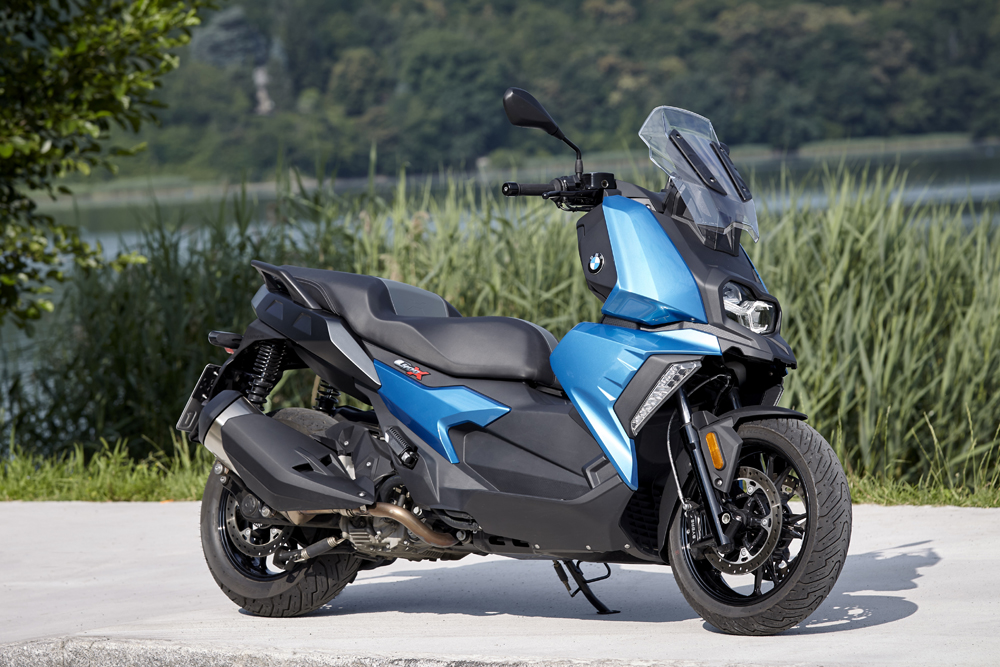
| SPECIFICATIONS |
2019 BMW C 400 X |
| ENGINE: |
Water-cooled, single-cylinder 4-stroke in-line, OHC engine, 4 valves |
| LUBRICATION: |
Wet sump |
| BORE & STROKE: |
80mm/69.6mm |
| OUTPUT: |
34 hp @ 7500 rpm |
| TORQUE: |
25.8 ft-lb @ 6000 rpm |
| COMPRESSION RATIO: |
11.5:1 |
| CARBURETION: |
EFI, BMS-E2 |
| CLUTCH: |
Centrifugal force dry clutch |
| TRANSMISSION: |
Continuously variable CVT belt |
| FRAME: |
Tubular spaceframe |
| FRONT SUSPENSION: |
Telescopic fork, 35mm |
| REAR SUSPENSION: |
Aluminum double-sided swingarm, double spring strut, adj. spring preload |
| FRONT WHEEL TRAVEL: |
4.3 in. |
| REAR WHEEL TRAVEL: |
4.4 in. |
| FRONT BRAKE: |
Rigid twin disc brake, 265mm, 4-piston floating caliper |
| REAR BRAKE: |
Rigid twin disc brake, 265mm, 1-piston floating caliper |
| ABS: |
BMW Motorrad ABS |
| WHEELS: |
Die-cast aluminum |
| FRONT WHEEL: |
3.50×15 in. |
| REAR WHEEL: |
4.25×14 in. |
| FRONT TIRE: |
120/70 ZR15 |
| REAR TIRE: |
150/70 ZR14 |
| SEAT HEIGHT: |
30.5 in. |
| INSIDE LEG LENGTH: |
69.3 in. |
| WEIGHT: |
450 lbs. |
| FUEL CAPACITY: |
3.4 gal./1.1 gal. reserve |